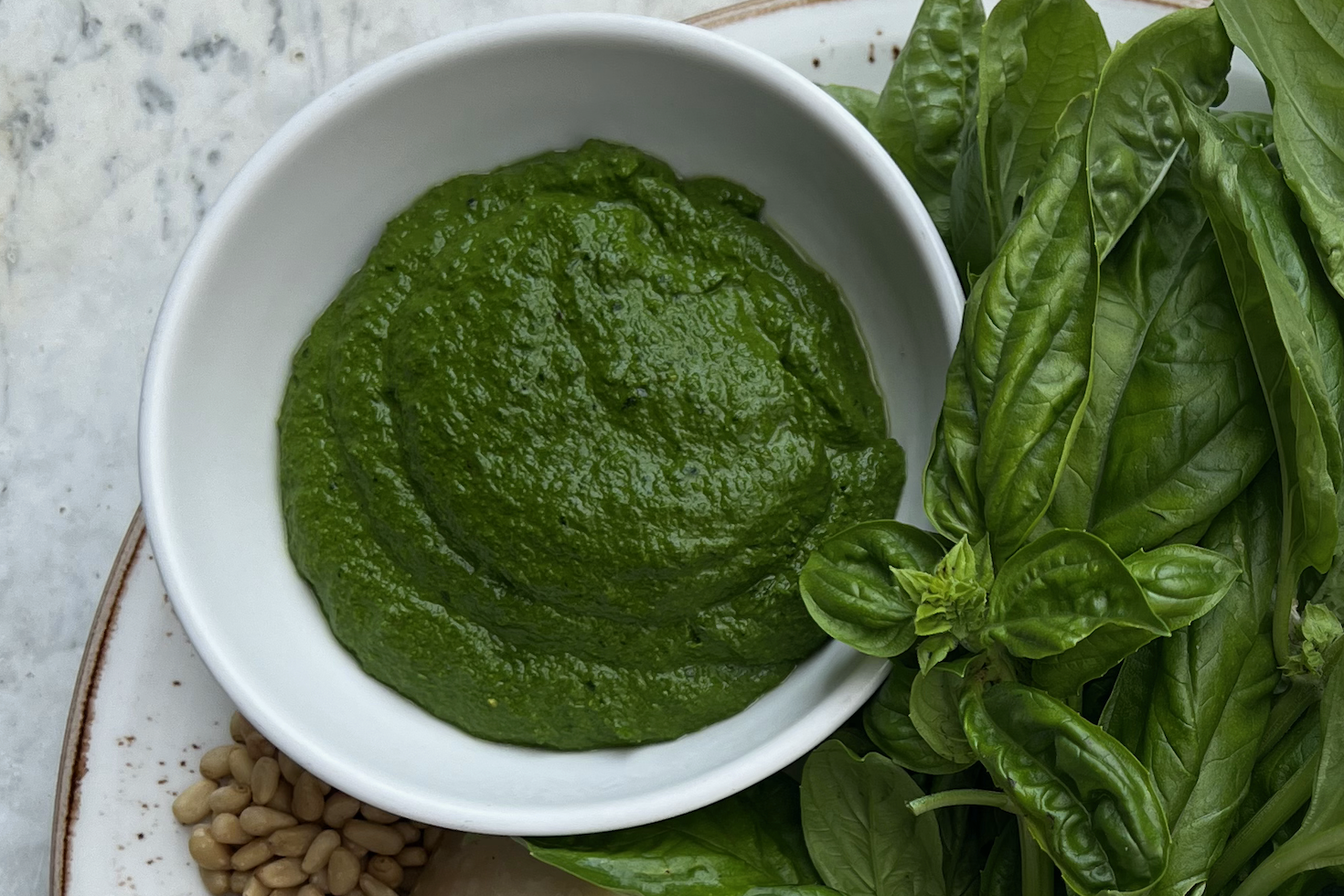Known for being the birthplace of the hard salami that bears its name, the northwestern Italian city of Genoa is also believed to be where pesto alla genovese was first made when an early culinary creator combined basil with pine nuts, garlic, Parmesan cheese and olive oil. Traditionally made using a mortar and pestle, the green condiment gets its name from the Italian verb pestare, which means “to crush” or “to grind.” Thought to be adapted from a pasty Roman dish called moretum that contained a mixture of herbs, cheese and garlic but not basil or pine nuts, pesto is now crafted in a myriad of different ways around the world and used as a pasta sauce, salad dressing, spread or dip.
At Chattanooga, Tennessee, restaurant Easy Bistro & Bar, chef de cuisine Joe Milenhovic uses everything from collards and turnips to ramps and kale to make his pesto. According to Milenhovic, as long as it contains something green alongside nuts, garlic, aged Italian cheese and olive oil, it’s pesto.
“You can use any variety of kale, root vegetable tops, broccoli, broccolini or any combination of soft herbs,” Milenhovic tells InsideHook. “That’s one thing I really love about Italian cooking. It’s so regionally diverse, even town to town, that people’s understanding of something we’ve tried to think of linearly is completely different. So I’ve made pesto with collard greens. I’ve made pesto traditionally with basil. I make ramp pesto during ramp season. With those fundamentals, you can play around and do whatever you need to do.”
“Moonstruck,” Not “Goodfellas,” Is the Essential Italian Food Movie
Plain buttered noodles and steak: it doesn’t get more Italian than thatMilenhovic spearheaded a house-made pasta program at Easy Bistro when he started there in 2020, after working at establishments including Hearth and Marea in New York City. He makes his pesto using a Vitamix blender instead of a mortar and pestle, and although it’s an Italian condiment, it’s also a bona fide staple in American kitchens.
“I feel like every cook has probably worked with a pesto,” he says. “I think every single kitchen I’ve worked in has had some variation. I got to work with some phenomenal, renowned chefs and badass cooks in New York City for about five years. Between doing that and being in the community and reading books, you pick things up. There was no pesto master. I just got to learn from some really phenomenal chefs over the years, and now I get to relay that knowledge to my cooks.”
Seeing as you don’t work in Milenhovic’s kitchen, he’s provided the following eight tips and a recipe for making a mint pistachio pesto that pairs well with lamb.
- An ice bath or cold water helps keep the color vibrant. Once the pesto is made, put it in an airtight container and submerge it in an ice bath until completely cool.
- Prepare the pesto one day in advance, at most. Day-of pesto is always best.
- Adding more or less of any ingredient is always based on preference, but a great pesto is harmonious in flavor and shouldn’t be dominated by cheese or nuts and seeds, in my opinion.
- Only use extra virgin olive oil.
- Always use Parmigiano Reggiano, pecorino romano or any other quality-controlled Italian aged cheese.
- Use more or less water, depending on if you want a chunkier pesto or more spreadable pesto.
- Have fun and use what’s around and fresh — this is the true Italian way.
- Even if you mess pesto up, it’s going to be good. Herbs are delicious — if you have a garden and a surplus, pesto is a great way to deal with it. It’s versatile. Bring it to a party with a loaf of bread and some crudités or mix it with pasta.
Chef Joe Milenhovic's Mint Pistachio Pesto
Total Time: 45 minutes
Servings: 4
Ingredients
- 3/4 cup mint
- 1/4 cup parsley
- 2 Tbsp. pistachios
- 1 clove garlic, microplaned
- 2 Tbsp. pecorino, microplaned
- 1 Tbsp. ricotta
- 1 lemon, juiced and zested
- 1/3 cup ice-cold water
- 1/3 cup extra virgin olive oil
- Salt and pepper to taste
Directions
-
-
In a Vitamix or blender, add pistachio, lemon juice and zest, garlic, Parmigiano, and some water. Puree.
-
Add ricotta and pulse. Add remaining water.
-
Add chopped herbs while streaming in olive oil. Be careful not to overwork the machine and create unwanted heat. Move quickly.
-
Add salt and pepper to taste. Portion into pints, covering the top with plastic wrap to prevent oxidation. Cool in an ice bath. Pesto should keep for about 2 to 3 days while refrigerated. If not consumed after that time period, freeze.
-
Join America's Fastest Growing Spirits Newsletter THE SPILL. Unlock all the reviews, recipes and revelry — and get 15% off award-winning La Tierra de Acre Mezcal.
